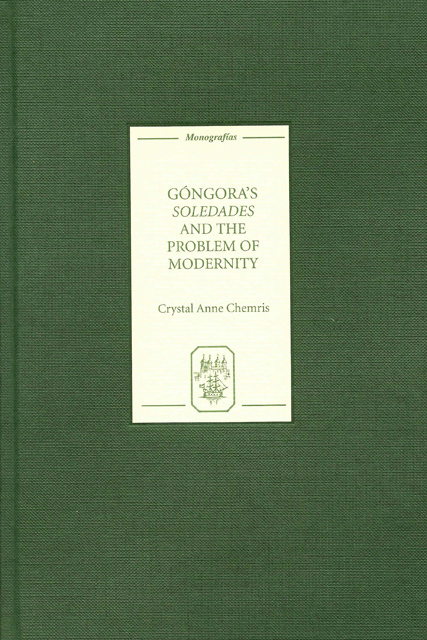Book contents
- Frontmatter
- Contents
- Dedication
- Foreword
- Acknowledgments
- Preface
- Introduction: Renaissance and Solitude
- 1 Crisis and Form
- 2 Violence, Eros and Lyric Emotion
- 3 Self and World: The Crisis of Perception in the Soledades
- 4 Time, Space and Apocalypse: The Falconry Scene as Disruption of Prophecy
- 5 Góngora and the Modern: “New Poetry”?
- Works Cited
- Index
Introduction: Renaissance and Solitude
Published online by Cambridge University Press: 03 May 2023
- Frontmatter
- Contents
- Dedication
- Foreword
- Acknowledgments
- Preface
- Introduction: Renaissance and Solitude
- 1 Crisis and Form
- 2 Violence, Eros and Lyric Emotion
- 3 Self and World: The Crisis of Perception in the Soledades
- 4 Time, Space and Apocalypse: The Falconry Scene as Disruption of Prophecy
- 5 Góngora and the Modern: “New Poetry”?
- Works Cited
- Index
Summary
“la soledad empieça a selle nueva”
Juan Boscán, “Soy como aquel”The Soledades cannot be understood without an appreciation of its heritage in the forces which shaped Renaissance literature. The breakdown in the feudal order gives rise to new literary forms which reflect the evolution of subjectivity, as society develops more modern social norms of inner life under the impact of what Norbert Elias has called the “civilizing” process. In general terms, writers begin to reframe their aesthetic goals, moving beyond imitation toward increased creativity, autonomy and expressiveness.
This movement toward greater innovation and subjectivity in art is accompanied by a problematic subjectivism. The loss of the Medieval worldview gives rise to ontological insecurity; during the Renaissance, the individual begins to experience a modern sense of uncertainty before the phenomenal world as well as a growing sense of isolation; the collective bond which the old order provided has been broken. These problems of subjectivism, uncertainty, and the isolation of individual consciousness, together with the Renaissance spirit of innovation, undergo a process of development which intensifies in the Baroque. I propose to isolate a particular succession of Renaissance writers whose works function as signposts in this process. Fernando de Rojas, Juan Boscán and Garcilaso de la Vega stand out as the creators of works which are pivotal to understanding the literary background of the Baroque ontological crisis, and thus to understanding the Soledades as a product of that crisis.
In the Celestina (1499), the touchstone for treating the ontological problems of the Renaissance is the theme of courtly love. The tradition of courtly love as Rojas receives it is a contradictory phenomenon. The courtier who pays service to a lady, who seeks pleasure in a love which will never be consummated, is engaged in a ritual which reverses the normal social order of man over woman. Huizinga points out that the ritualistic vassalage of the courtly lover idealizes a brutal reality; the worship of woman, modeled in part on the cult of the Virgin, was but the obverse of the degradation of woman in feudal society. In a world where marriage was arranged to unite properties, women were virtually sold with their dowries, and love could only be incidental to matrimony.
- Type
- Chapter
- Information
- Góngora's Soledades and the Problem of Modernity , pp. 1 - 20Publisher: Boydell & BrewerPrint publication year: 2007



